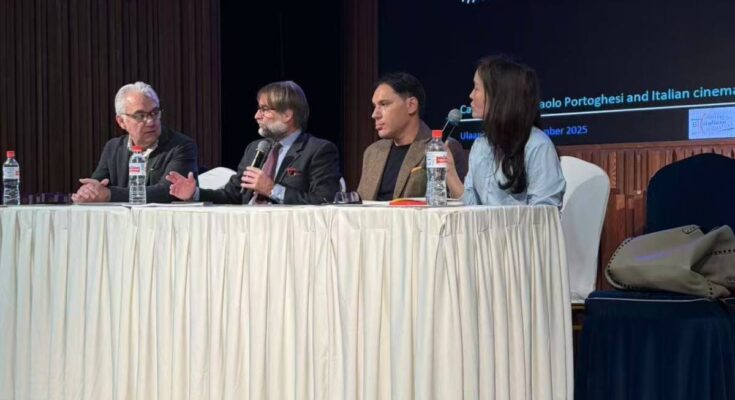After the success recorded in Beijing, the volume of Asian travel Papanice House by Edmondo Papanice continues to gain consensus. The work, dedicated to the famous creations of architect Paolo Portoghesi, made stops in Ulaanbaatar (November 1) and Seoul (November 5), attracting growing interest among scholars, architects and the curious from the Far East.
A success that is not only editorial, but also cultural: a bridge between Italy and Asia built with pencils and memories. Behind the scenes, the initiative is supported by the Italian Cultural Institutes in Beijing and Seoul, in collaboration with the Italian Embassies in Mongolia and Korea, and with the support of the HALP Association. An exhibition dedicated to the Romanesque building was held in both capitals, with archival photographs and original materials telling the story of the origins of one of the most emblematic houses of 20th century Italy. In the Mongolian capital, at the Aurug Place cultural center, the director of the Italian Cultural Institute in Beijing, Federico Antonelli, recalled how “paying homage to the figure of Paolo Portoghesi and his Casa Papanice in Ulaanbaatar” meant bringing inside Asia the cultural thread that unites Borromini, the Baroque, and the great masters of the twentieth century. As many as 700 Mongolian architects attended the meeting, a sign that interest in Italian design and architectural traditions was far from marginal. Together with Antonelli, Italian Ambassador to Mongolia Giovanna Piccarreta, architect Luciano Cosmo (IQP Italdesign) and Batjav Batkhuyag, honorary president of the Union of Mongolian Architects, spoke. On the table are concrete prospects for new collaboration between the two countries in the field of architecture and design.
In Seoul, an Italian High Street setting welcomes a Korean stage. The Regent of the Italian Cultural Institute, Erika Fascia, defined Casa Papanice as “a place of affection, vision and connection”, underlining Edmondo Papanice’s commitment to preserving the building’s original identity.
The Italian Ambassador to Korea, Emilia Gatto, praised the volume for “recovering the charm of one of the most studied Italian houses in the world”. The intervention made by Professor Chun Jinyoung (Myongji University) was also extensive, who proposed a critical reading of Portoghesi’s work, even going so far as to hypothesize the future recognition of Casa Papanice as a World Heritage Site. While living in Seoul, Edmondo Papaniceaccompanied by Chun himself, visited a building inspired by Casa Papanice, built in the heart of the city park. A real tribute to the symbolic power of a work that continues to give birth to architecture, as well as reflection. A sign that the Portoghesi “homestead” is not just an Italian monument, but a source of inspiration for the world.
HALP president and editor of the volume, Edmondo Papanice was able to turn the encounter with the public into a journey through memory, cinema and domestic life, returning Casa Papanice to its most authentic dimension: the human one. The Asian tour, after Beijing, Ulaanbaatar and Seoul, thus consecrated Casa Papanice as an ambassador of Italian creativity and Portuguese heritage in the world.
And its success does not stop there: as announced by television manager Lucio Presta, a documentary dedicated to the history of the building is already in production. A clear signal that Casa Papanice is not just a physical place, but a living symbolItalian architecture who continue to speak – even in the East – the language of genius.



